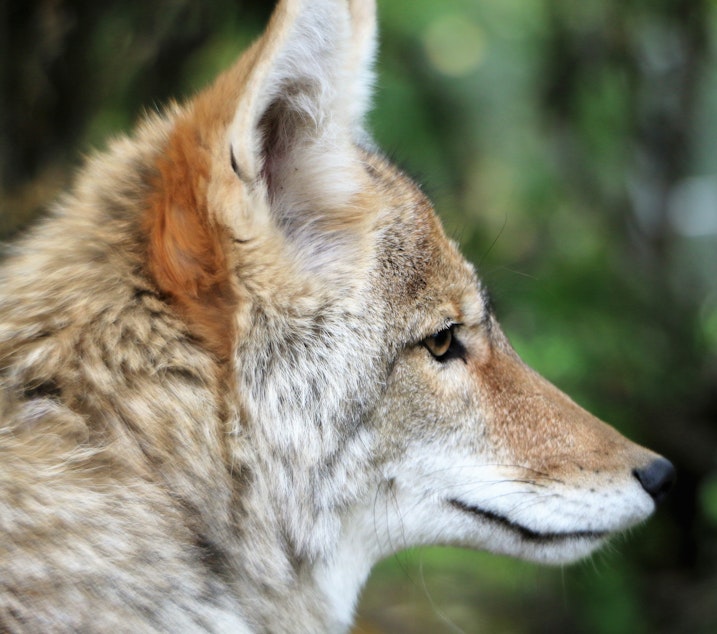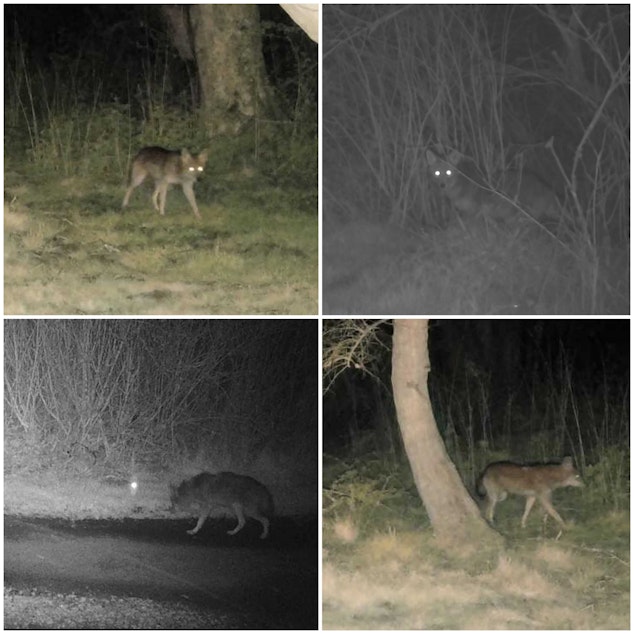Coyotes are here to stay in Seattle's urban core. So how can we coexist?

I
t was Mother's Day last year when around 4 a.m., Jayne Smith heard screaming outside of her Queen Anne home.
She knew immediately it was her cat, Storm. Smith got out of bed and took off.
“Not something you ever want anyone to go through,” Smith told KUOW, “hearing a pet scream like that in the middle of the night and be woken up that way.”
She got outside in time to see her fluffy yellow cat in the mouth of a large gray coyote. Smith chased the Coyote and Storm down the street, barefoot, cold, and crying out.
Sponsored
"All I thought was, ‘I need my cat back,’ Smith said. “I thought he was already gone because he was hanging limp. The coyote was holding him by the head."
Thankfully, Smith did get Storm back after the coyote dropped him and ran away. She drove Storm to an emergency vet where he had surgery.
RELATED: It's coyote o'clock in Seattle. Should you bring your cats in?
Today Storm is back to his old self: playful, feisty, and prone to knocking stuff off of tables. But Smith wants to get the word out about pet safety as wildlife encounters become increasingly common in the area.
"There are so many other people in Seattle who just… their pets vanish and they never know what happened,” she said. “Well, the city is rife with coyotes."
Sponsored

The Seattle area has been at the center of several coyote stories lately: People have reported their dogs being bitten; there have been sightings of coyotes trotting around the Ballard and Capitol Hill neighborhoods; and even KUOW reported last month that two coyotes were put down after nipping young kids waiting at a bus stop in Bellevue.
RELATED: 2 Bellevue coyotes killed by state after nipping children
These stories have elicited a strong response in online groups.
Some people have expressed delight about see some urban wildlife with comments like, “Let nature do its thing!”
Sponsored
Others, like Smith, are not so comfortable with coyotes nearby and encourage others to scare — or “haze” — coyotes away by waving their arms and shouting.
Others have advocated for a more aggressive approach to handling the coyotes, saying they're too dangerous for the city environment and should be killed.
But wildlife experts agree that permanently removing coyotes from Seattle or western Washington is pretty much impossible: They’re too adaptable and too crafty. When one coyote is killed, another one quickly takes its place.
Washington’s Department of Fish & Wildlife poetically states online that “the coyote’s tenacity tries some people’s patience and inspires others’ admiration.”
Gary Stuntz knows a lot about living with coyotes. Almost every week, one of his trail cameras near Coupeville on Whidbey Island picks up a lone coyote out for a morning hunt, often just a few dozen feet from Stuntz's house.
Sponsored
At night he can hear a group of several coyotes howling and yapping to each other. Stuntz thinks it's entertaining but said he knows not everyone loves that sound.
“There are a lot of people who get a little sensitive about hearing the...coyote because they're worried that they're going to get attacked or they’re going to lose their cat or a small dog,” he said.

Stuntz is a sportsman who mostly hunts deer but also shoots about 20 to 25 coyotes every year. With 100, he can stitch the pelts together to make a queen-sized bed spread.
“They’re actually quite beautiful,” Stuntz said. “The hides on them are very smooth and warm.”
Sponsored
He gets calls from neighbors wanting him to shoot pesky coyotes that hang around livestock or chicken coop.
“I've had probably 10 or 15 people that have asked me to come out and hunt their properties,” Stuntz said. “And sometimes people think that there are 20 or 30 coyotes that are in their backyard, and it turns out to be one or two."
But even as someone who shoots about two coyotes every month, Stuntz said people should accept that the wild canines are part of the western Washington community.
“People can get a little anxious and wound up about it. The biggest thing to do is just breathe and just realize that it's O.K.,” he said. “They're just doing what they do. They're just coyotes.”
Meanwhile in Seattle, Sam Kreling, who recently earned a doctorate studying urban coyotes at the University of Washington, said the city's "coyote population is likely not really changing much year to year,” despite the increase in human-coyote encounters.
Rather, “pretty much every green space is filled up with a coyote family,” she said.
They're everywhere: Parks, creeks, maybe even your backyard. And unlike in rural areas, physical space is the limited resource for Seattle coyotes — not food, Kreling said.
RELATED: Howl you doing? City coyotes tell all
But not because they’re feasting on house cats, she added.
"They are mainly eating rabbits,” Kreling said. “All of those cottontails you see running around the city — those are actually not native to the area, so [coyotes] are kind of doing a service by eating them all up, making sure that they're not chewing up our gardens."
Coyotes help with other environmental pests too, she said
“My opinion is that coyotes are actually really helpful for the city. For the most part, Seattle has tons and tons of invasive species, from those cottontails to black rats that spread disease. Coyotes can really help us manage those populations.”
It’s not just rabbits and rodents, though. Coyotes are scrappy omnivores that can eat a lot of different foods, including native fruit like pears and apples.
“Seattle spends millions of dollars a year trying to restore a lot of our green spaces ,and by eating those fruits and dispersing the seeds, they actually might be helping us restore these green spaces,” Kreling said.

Jayne Smith, who's cat Storm was almost eaten by a coyote, said she doesn't hold a vendetta against the animals but is much more aware of wildlife around her in the city now.
"You think you're protected from a certain amount of things by being in an urban area, but you're not,” she said. “The animals have adapted. They are very much here to stay."
Smith added that she wants pet owners to stop leaving their animals outside to become potential coyote prey. It’s up to us, the smarter species, Smith said, to also adapt and prevent attacks.
For her part, Kreling said the best thing we can do is to learn to live with and maybe even appreciate the presence of coyotes.
“We are in a sixth mass extinction,” she said. “I think we should kind of celebrate the animals that are not only just surviving but thriving in this time period.”

